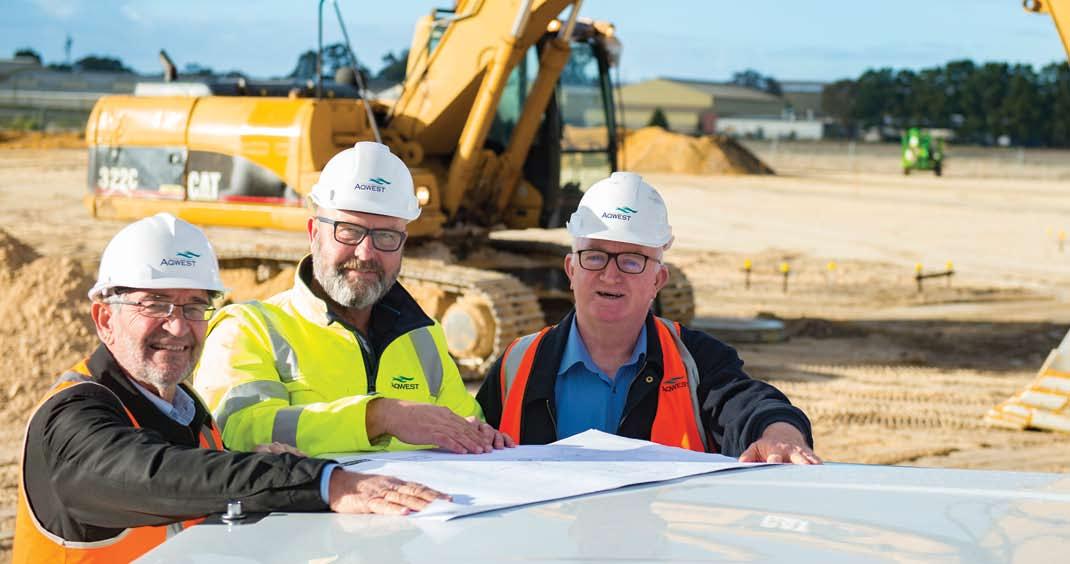
4 minute read
New water treatment plant to meet future needs of Bunbury
Bunbury’s new highly efficient, modern water treatment plant has been designed to meet the future water needs of WA’s second city.
Aqwest was given approval by the State Government in November 2017 to start design and construction of the $15 million plant, which is taking shape at Bunbury’s inland suburb of Glen Iris and scheduled for completion in April this year. When finished, the plant will be capable of producing up to 12 megalitres of drinking water a day, supplying Aqwest’s 35,000 customers and other potential customers into the future.
The plant is a key element of Aqwest’s strategic development plan to relocate water production away from the sensitive seawater/freshwater interface between the Yarragadee Aquifer and the Indian Ocean.
Aqwest uses bores near the coast to draw water from the aquifer, which is a large underground fresh water source. According to Aqwest Chief Executive Officer Gary Hallsworth, due to the impacts of climate change, the risk of increasing salinity levels near the coastal bores is threatening water quality.
“The new water treatment plant will extract water from a high quality, sustainable in-land groundwater source, creating greater water production cost efficiencies and delivering benefits to our customers,” Mr Hallsworth said. “By planning for the future, Aqwest is continuing its commitment to provide sustainable, high quality driving water that consistently meets or exceeds our customers’ expectations.”
When completed, the new treatment plant at Glen Iris will be open for public and school tours so people can see first hand where their water comes from and learn about the water treatment and distribution process.
Article by Aqwest
Where does Aqwest operate?
Aqwest is a West Australian Government Trading Enterprise responsible for providing drinking water to the City of Bunbury and surrounding areas, which includes about 17,000 properties.This includes Bunbury, parts of Dalyellup and the Picton industrial area, however its operating licence matches the boundary of the Greater Bunbury Regional Scheme, from north of Harvey and Myalup to south of Capel. It produces water from an integrated treatment and distribution system which includes 12 bores, six water treatment plants, four reservoirs, one water tower and about 380 kilometres of water mains. Aqwest operates independently from the Water Corporation and is the sole provider of water for the Bunbury region.
AQWEST’s OPERATING LICENCE AREA
Map Key Current Water Supply Assets Operating Licence Area Roads / Highways Towns
BUNBURY
DALYELLUP MYALUP
BINNINGUP
AUSTRALIND
EATON
PEPPERMINT GROVE BEACH
CAPEL BOYANUP
DONNYBROOK HARVEY

Above: Aqwest Chair Stan Liaros, Chief Executive Officer Gary Hallsworth and former Chief Executive Officer Brad Bevis look over the plans for the new Glen Iris Water Treatment Plant.
Where does our water come from?
Not from dams or desalination plants – Bunbury’s water is pumped by Aqwest from the Yarragadee Aquifer. This large, fresh water source is deep underground and stretches from Geraldton in the north to the south coast of WA. The aquifer stores about 1000 cubic kilometres of water.While it is recharged with rainfall which percolates through the ground, it is still a limited resource which must be conserved and protected. The water used now will affect the amount of water available in the future.

Aqwest water treatment process
The Yarragadee Aquifer and contains some iron, manganese and other minerals absorbed from the soil. When the water is pumped to the surface it is sprayed into the open air via purpose built aerators. This adds oxygen to the water and aids in the removal of iron and manganese. Chlorine is added to the water to act as a disinfectant against potentially dangerous bacteria. Chlorine is used around the world for water treatment because it is a very effective disinfectant, is economical and provides protection all the way from the
treatment plant through to the customer’s tap.From the aerator, the water is then passed through sand filters, which are large tanks each standing seven metres high. The water is pumped into the bottom of the tank and then it slowly rises through the layers of sand. The sand captures iron, manganese and any other impurities in the water. The impurities which are trapped in the sand are removed via a continuous backwashing process. Waste water from this process is captured and the impurities allowed to settle out in large settling tanks. The impurities are then concentrated into a product known as sludge and dried in sludge drying beds.The filtered water which discharges though the top of the sand is then safe to drink and complies with all of the requirements of the Australian Drinking Water Guidelines. From there it is pumped to one of Aqwest’s water reservoirs ready to be delivered to our customers’ taps.









